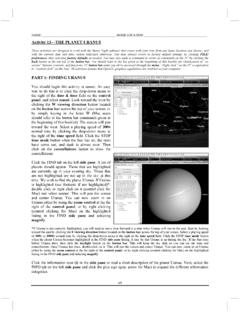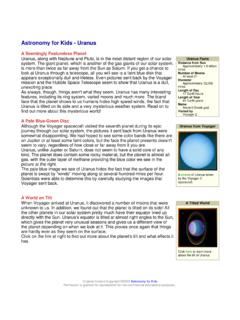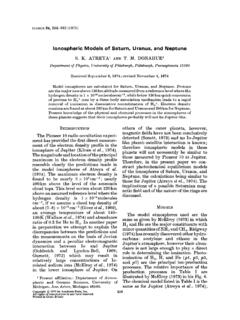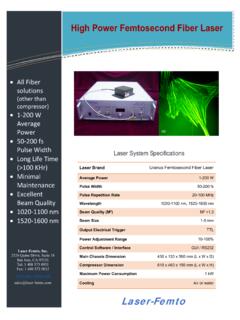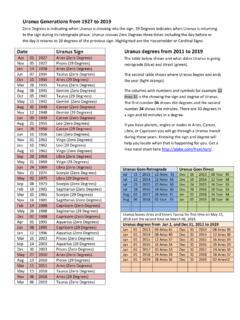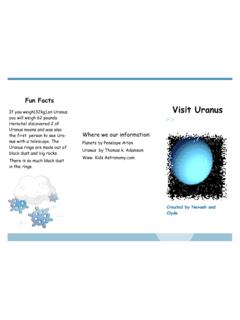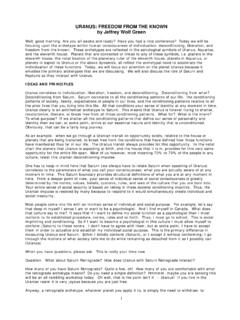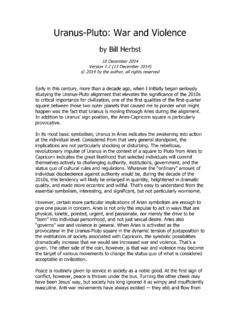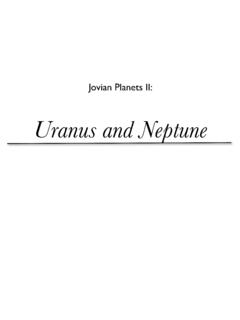Transcription of Jupiter , Saturn, Uranus, Neptune - hosting.astro.cornell.edu
1 Lecture 4: Overview of the Giant PlanetsAstro 202 Prof. Jim Bell 2008 But in Paper 1 nowPaper 2 is Handed Out onlinePaper 2 due at beginning of class on Feb. 14 Don t wait until the last minute!This just in from ProbeAstro 2024 Jupiter , Saturn, uranus , Neptune !General properties!Atmospheres!Interiors!Ring SystemsAstro 2025 The Jovian PlanetsAstro 2026 Basic Properties of Jupiter Average Distance from Sun: 778,000,000 km (a= AU) Orbital period: years; eccentricity: Period of Spin around axis: ~10 hours (varies with lat.) Tilt of Jovian spin axis: (no real seasons) Mass: kg = 317 ME ; Radius: 71,400 km = 11 RE Density = g/cm3 (mostly gaseous, small "rocky" core?) No "surface" like the terrestrial planets: only clouds visible Gravity = m/sec2 ( times Earth's) Cloud-top temperature: 125 K (-148 C) Atmosphere: Mostly H, He (plus CH4, NH3, H2O, NH4HS.)
2 Moons: 63 presently known Rings: Jupiter has an elegant set of thin dark ringsAstro 2027 Observations! Jupiter is a prominent object in the night sky for many months out of each year!Through even a small telescope, Jupiter 's clouds appear yellow, red, and brown!And features can be seen Belts of red clouds Zones of white clouds Oval-shaped stormsAstro 2028 Space Missions!7 robotic spacecraft have flown past Jupiter !1 more orbited Jupiter from 1995 to 2003 Mission Dates Goals and Results Pioneer 10 1973 First Jupiter flyby; studied magnetic field, cloudsPioneer 11 1974 Flyby; studied magnetic field, atmosphereVoyager 1 1979 Flyby; high resolution imaging and other studiesVoyager 2 1979 Flyby; high resolution imaging and other studiesUlysses 1992 Flyby (Sun gravity assist); solar wind & magnetic fieldGalileo 1995- Orbiter; imaging, spectroscopy, magnetic fields, 2003 and atmospheric entry probeCassini 1999 Flyby (Saturn gravity assist); imaging, spectroscopyNew Horizons 2007 Flyby (Pluto gravity assist).
3 Imaging, spectroscopyAstro 2029 Voyagers 1 and 2!Astro 20210 Jupiter 's Dynamic Atmosphere!The zones, belts, and storms change with time!The most famous storm, the Great Red Spot, has been around at least since 1610 Jupiter rotationJupiter cloud motions(rotation removed)Astro 20211 Atmospheric Composition!Determined by spectroscopy from telescopes and spacecraft!Directly sampled by the Galileo probe Name Symbol % Volume Hydrogen H2 90 Helium He Methane CH4 Ammonia NH3 Ethane C2H6 Deuterated Hydrogen HD x 10-3 Water vapor H2O 1 x 10-4 Deuterated Methane CH3D 3 x 10-5 Phosphine PH3 1 x 10-6 Carbon monoxide CO 1 x 10-7 Germanium Tetrahydride GeH3 ?
4 1 x 10-7 The composition of Jupiter is very close to the composition of the SunGalileo Probe MissionRelease Date: 7/13/95 Entry into Jupiter : 12/7/95 Entry Speed: 106,000 mphProbe Data Return: 59 min megabitsPenetration depth 200 km (124 mi)Astro 20212 Beltsand ZonesKnowledge of the composition & temp. allows astronomers to create a model to explain the distribution and colors of the belts and zones Astro 20213 Atmospheric Circulation Great Red SpotAstro 20214 Jupiter 's Interior Interior structure is inferred from models and extrapolation of data from the upper cloud 20215 Internal vs. External Heat Sources!Energy Balance What comes in must go Solar heat absorbed = Outgoing planetary heat!
5 But for Jupiter : Outgoing = ! Incoming! Jupiter has a strong internal heat source Heat stored from planetary contraction? From some other source?!This has a strong influence on atmospheric circulation and the "climate" of Jupiter More in Lecture 20216 Giant Planet or Failed Star?!Calculations suggest that Jupiter is about 100 times less massive than needed to initiate hydrogen fusion reactions in its core and become a star. !Since factors of 100 are not so large in astronomy, it is legitimate at some level to view Jupiter as either a very large planet, or as a small failed star. Astro 20217 Jupiter 's Magnetic Field!The largest planetary structure in the solar system (apparent size > the full Moon) Jupiter 's magnetic field is about 20,000 times stronger than Earth's The solar wind is deflected in a huge zone around the planet Evidence for the magnetic field can be seen in telescope and spacecraft images of auroraeAstro 20218 Satellites &Rings!
6 Galileo discovered the 4 large moons of Jupiter in 1610 We call them the Galilean satellites!12 other smaller moon found: 1872-1979!Dozens more even smaller found since 99 Total is now 63! ( )! Jupiter also has a faint, thin ring systemAstro 20219 SaturnAstro 20220 The Jovian Planets Astro 20221 Basic Properties of Saturn Average Distance from Sun: billion km (a= AU) Orbital period: years; eccentricity: Period of Spin around axis: ~10 hours (varies with lat.) Tilt of Saturn's spin axis: (seasons and tilted rings) Mass: kg = 94 ME ; Radius: 60,270 km = RE Density = g/cm3 (mostly gaseous, small "rocky" core?) No "surface" like the terrestrial planets: only clouds visible Gravity = m/sec2 ( times Earth's) Cloud-top temperature: 95 K (-178 C) Atmosphere: Mostly H, He (plus CH4, NH3, H2O, NH4HS.)
7 Moons: 60 presently known Rings! Billions of icy moonlets all orbiting togetherAstro 20222 Observations!Saturn is the most distant planet that can be (easily) seen without a telescope !Through a small telescope, Saturn's yellow clouds and spectacular rings can be seen!Features in Saturn's atmosphere are much more subtle than in Jupiter 'sAstro 20223 Space Missions!3 robotic spacecraft have flown past Saturn!Cassini has been orbiting Saturn since 2004 Mission !Dates!Goals and Results Pioneer 11!1979!First Saturn flyby; studied magnetic field, cloudsVoyager 1!1980!Flyby; high resolution imaging and other studiesVoyager 2!1981!Flyby; high resolution imaging and other studiesCassini!
8 2004-!Orbiter; imaging, spectroscopy, magnetic fields,!!satellite radar mapping; !!Huygens entry probe landed on Titan: Jan. 2005 Astro 20224 Features in Saturn's Atmosphere!Zones, belts, and storms like Jupiter !But smaller, lower contrasts, and shorter lifetimesSaturn rotationAstro 20225 Atmospheric Circulation!Saturn has stronger equatorial winds than Jupiter !Wind patters & "shear" different than Jupiter 'smax > 1800 mph!Astro 20226 Atmospheric Composition!Determined by spectroscopy from telescopes and spacecraft!Similar to Jupiter , but less H2O, more C H Name Symbol % Volume Hydrogen H2 94 Helium He 6 Methane CH4 8 x 10-4 Ammonia NH3 2 x 10-4 Deuterated Hydrogen HD 5 x 10-5 Deuterated Methane CH3D 2 x 10-5 Ethane C2H6 5 x 10-6 Phosphine PH3 1 x 10-6 Acetylene C2H2 2 x 10-8 Propane C3H8 1 x 10-10 The composition of Saturn is also very close to the compo-sition of the Sun}Minor trace gasesH2O?
9 Astro 20227 Saturn's Interior!Estimated using same methods as !Shape of Saturn particularly revealing: Saturn is very oblate (a flattened sphere)Astro 20228 Saturn's Interior Like Jupiter , Saturn's interior structure is inferred from models & extrapolation of data from upper cloud layers. Hydrogen and helium at immense pressures and temperaturesAstro 20229 Saturn:Internal vs. External Heat Sources!Again, examine the energy balance !For Saturn: Outgoing ! ! Incoming!About the same as Jupiter , but Saturn only receives about 25% as much sunlight So the heat source is unlikely to be related to the solar !Saturn must have a strong internal heat source Heat stored from planetary contraction (gravitational)?
10 Heat released from interior phase changes? Primordial? Radioactive? ??!Internal heating must also have a strong influence on atmospheric circulationAstro 20230 The Cassini Mission to SaturnPower for the instruments on Cassini comes from a small nuclear reactor(~ 72 lbs of 238Pu)Astro 20231 Satellites!Dutch astronomer Christian Huygens discovered Saturn's large moon Titan in 1655 Titan has a thick and complex atmosphere!!17 other smaller rocky/icy moons found: 1671-1990!Dozens more tiny outer moons found since then!Total is now 60! ( )(More in Lecture 5)Astro 202 Rings! Saturn's rings are made of millions of house-sized chunks of "dirty ice", all sharing similar orbits Origin? Unknown!The rings are only about 100 m thick!
